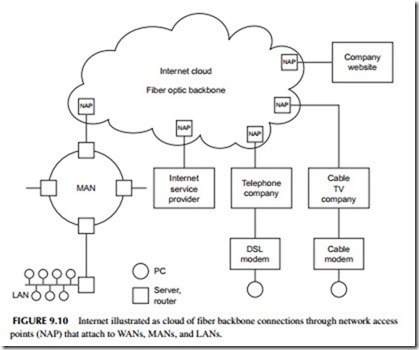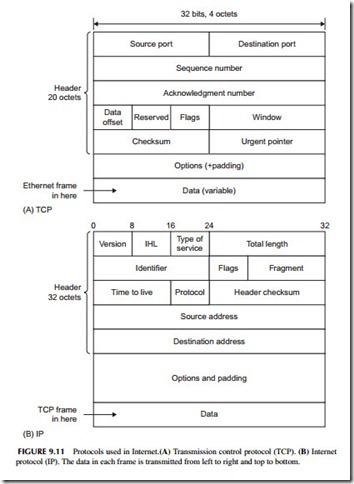HOW THE INTERNET WORKS
The Internet is an enormous WAN covering the entire world. It consists of many super-fast, fiber optic cable links that are generally referred to as the backbone of
the network. These high-speed links are owned by companies and governments and provide connection points for companies, governments, WANs, Internet service providers, and hosts for websites. These connection points are known as network access points (NAPs). See Figure 9.10. There are dozens of NAPs in the United States and they provide the link to the backbone connections. These backbone connections are worldwide. Because they are complex and interlinked, they are often referred to as the Internet cloud. Since data being transmitted from one point to the other can go by multiple paths in the backbone, there is no way to know the exact path, so the cloud designation is appropriate. You put the data transmission into one NAP entry point to the cloud and it comes out in another. From there it goes to other MANs and LANs for connections to other networks and to individual users.
Data is transmitted over the Internet using a standardized method referred to as TCP/IP. This means transmission control protocol/Internet protocol. Both are protocols for building packets that are transmitted over the Internet.
Assume that a LAN and MAN using Ethernet want to transmit information over the Internet. The Ethernet packets are then sent to a NAP where they are assembled into the packets that actually get transmitted over the fiber optic cable. The TCP assembles the data to be transmitted into unique packets and attaches a header to it, giving the source and destination addresses, a sequence
number, and some error detection and correction information. The general for- mat is shown in Figure 9.11A.
The TCP packets then become the data that is assembled further into Internet packets (see Figure 9.11B). The Internet protocol attaches a header giving source and destination addresses as well as other information about where and how the data is to be sent.
The IP header contains a 32-bit destination address identifying the location of the computer receiving the data. This 32-bit address is divided into four 8-bit segments. Each 8-bit segment is usually referred to by its binary equiva- lent. The result is the IP address. Every computer and most other devices have an IP address assigned by an organization set up for assigning and managing Internet addresses. You may have seen the address referred to in the format 51.78.23.189. This is called the dotted decimal format.
With a 32-bit address, over 4 billion individual computers and other devices can be assigned a unique address. However, we are already beginning to run out of addresses and a new updated form of Internet protocol called IPv6 (Internet Protocol version 6) is gradually replacing it. It has a 128-bit address that provides billions and trillions of additional addresses so that even the smallest inconsequential device can have its own Internet address.
As the data is transmitted over the Internet, it passes through many devices referred to as routers. The router is the basic transmission control device of the Internet. What the router does is examine all of the packets transmitted to it and specifically looks at their IP destination addresses. The router temporarily will store data being transmitted and then decide which part of the network it should be connected to next to reach its desired destination. Routers store sets of information called routing tables that help the router decide the best trans- mission path through the Internet.
The data being transmitted ultimately reaches the NAP connected to the network where the destination exists. This may be a company, MAN, or LAN, or it could be an Internet service provider, such as the telephone company or cable TV company that will ultimately connect to the source computer. The source computer then strips away the TCP/IP headers to recover the original Sonet or Ethernet data.

